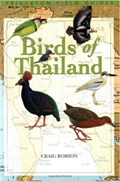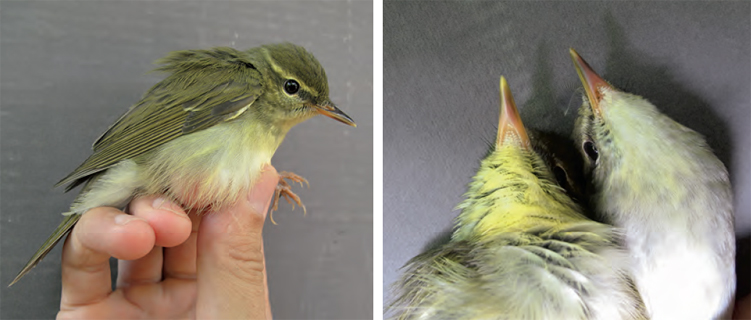
|
||||||||||
|
||||||||||
| Favorite Tweets by @thaibirding | ||||||||||
|
||||||||||
 Buy Birds of Thailand on Amazon.co.uk |
||||||||||
| Site Map ; Contributors |
| A
record of Japanese Leaf Warbler Phylloscopus xanthodryas in Thailand By Philip D. Round, Andrew J. Pierce, Chukiat Nualsri & Wangworn Sankamethawee |
||
| Tweet | ||
| Note:
This article was originally published in BirdingAsia 23 (2015) the
buletin of the Oriental
Bird Club (OBC) and was kindly submitted by Philip
D. Round. Please support the OBC's conservation work by visiting the OBC website and becoming a member. |
||
| We
document the capture and ringing of a Japanese Leaf Warbler Phylloscopus
xanthodryas on the island of Ko Man Nai, Klaeng district, Rayong
province, Thailand, on 14 April 2013. The island lies about 5.5 km
off the coast of south-east Thailand at 12.613°N 101.688°E,
and has a land area of less than 0.5 km². The bird was caught in a line of ten mist-nets, oriented roughly east-west, through dense woodland, combining a mixture of seasonal secondary evergreen forest, littoral vegetation, bamboo, naturalised plants and abandoned orchards consisting of mango trees and coconut palms. Immediately on extracting it from the net at 13h00, WS remarked on its relatively large size and strongly yellow appearance. It was fitted with a numbered Department of National Parks, Wildlife and Plants Conservation metal ring, measured, weighed and photographed before release. A detailed wing formula was taken. No calls were heard at any time. The long supercilium was evenly yellow-washed along its entire length, framed below by a broad dark eye-line and above by a crown slightly darker at the sides than the centre. A partial eye-ring, visible above and below the eye was similarly yellowish, slightly brighter and cleaner yellow than the supercilium. The throat was evenly yellow-washed to the base of the bill. The breast, flanks, centre of belly and undertailcoverts were whitish suffused or streaked with yellow. The upperparts were relatively bright green, and showed a single short (greater covert) wing-bar formed by whitish tips to the outer webs of the three outermost greater coverts. The legs were medium-brown with yellow undersides to the toes. The bill, which was long and thick for a Phylloscopus, was blackish-brown on the upper mandible, whitish-horn at the extreme of the slightly hooked tip and orange-pink on the lower mandible, paler whitish horn-coloured at the tip and with a dusky suffusion laterally on the distal half (Plates 1 & 2). Wing-length (maximum chord) was 75 mm, tail 54 mm. Bill length (measured to skull) was 16.3 mm, width at base of the nostrils was 4.5 mm and at the distal edge of the nostrils was 3.6 mm. Bill depth at the distal edge of the nostrils was 3.1 mm, and tarsus 20.2 mm. Weight was 9.4 g. Wing point p3 (p4 sub-equal); p2 7.0 mm, tip lying roughly opposite p6. Outermost primary (p1) 3.5 mm longer than longest primary covert. Outer webs of pp 3, 4, & 5 emarginated. The combination of the strongly yellow-suffused underparts, large size, long broad bill and the relatively long outermost primary were sufficient to rule out Arctic Warbler P. borealis. Some large, male Kamchatka Leaf Warblers P. examinandus may be similarly long-winged but neither species is ever as bright yellow as the present bird. The Japanese Leaf Warbler was caught more or less simultaneously with two other warblers considered almost certainly to have been Kamchatka Leaf Warblers, due to their long wings (69 and 72 mm, respectively) in comparison with Arctic Warblers, from which they appeared more or less indistinguishable in plumage. Feathers were collected from both putative Kamchatka Leaf Warblers and from the Japanese Leaf Warbler, but have not yet been subjected to DNA assay. Kamchatka Leaf Warbler has previously been identified among Thai-ringed birds from examination of the COI gene (Round et al. in prep.) while this is thought to be the first record of Japanese Leaf Warbler in Thailand. |
||
 |
||
| These
three taxa, P. borealis, P. examinandus and P.
xanthodryas were only recently recognised as distinct lineages
(Saitoh et al. 2006, 2008, 2010, Alström et al.
2011) and their winter ranges are not well known. Dickinson &
Christidis (2014) gave the winter range of P. b. xanthodryas
as ‘Philippines, E Indonesia’. Ticehurst (1938) listed
non-breeding season (winter) records of P. xanthodryas for
Borneo, Philippines, W. Java and Sumatra, and P. examinandus
for the Lesser Sundas. P. xanthodryas has evidently been
caught on spring passage in Hong Kong (Carey et al. 2001).
A small number of longwinged or unusually greenish individuals tentatively
considered to be P. xanthodryas from far southern Thailand
and Peninsular Malaysia (Wells 2007, D. R. Wells in litt.) are perhaps
more likely to have been P. examinandus, formerly subsumed
under P. xanthodryas. However, given the similarity of all
three taxa, these records should be reassessed. It is possible that
there may yet be some unrecognized Japanese Leaf Warbler specimens
in collections for mainland South-East Asian countries. Ko Man Nai offers exceptional opportunities for the study of northward landbird migration across the Gulf of Thailand. With only partial coverage during the springs of 2012–2014, a total of 2,175 birds of 67 species have been ringed, of which 93% were migrants. This included ten Vulnerable Fairy Pittas Pitta nympha, perhaps indicating that a population of this globally threatened species winters further west in the Sunda subregion than is currently known. The Vulnerable Brown-chested Jungle Flycatcher Rhinomyias brunneatus (15 ringed) was regular, as was the Near Threatened Japanese Paradise-flycatcher Terpsiphone atrocaudata (77 ringed). Both Narcissus Flycatcher Ficedula narcissina (six ringed) and Greenbacked Flycatcher F. elisae (18 ringed) were caught. This suggests that the island could be a suitable station for longterm population monitoring of scarce, lowland forest winter visitors that breed further north in Asia, and winter in the Sunda subregion. Many such species are declining and are of conservation concern. Both Crow-billed Drongo Dicrurus annectans (159 individuals) and Siberian Blue Robin Luscinia cyane (525 individuals), among the most numerous migrants caught and ringed, were considered to be under threat regionally by Wells (2007) due to the great reduction in their lowland forest wintering habitat. |
||
| ACKNOWLEDGEMENTS We thank Takema Saitoh and Yoshi Shigeta, Yamashina Institute for Ornithology, for their helpful comments on the identification of our bird from photographs, and David Wells for commenting on an earlier version of this manuscript. The Department of Marine and Coastal Resources (DMCR) granted permission to study birds on Ko Man Nai, and provided accommodation and transportation. In the DMCR we are especially grateful to the Ko Man Nai station chief, Suthep Jaulaong, Pinsak Surasawasdi, Director of Research, Central Region and Bamroongsak Chatanantavej, Rayong Marine and Coastal Resources Conservation Research Center for expediting our work. We thank the Department of National Parks, Wildlife and Plants Conservation for supplying rings, and Jonathan Murray for his assistance in the field. Philip Round is supported by The Wetland Trust (UK). |
||
| REFERENCES Alström, P., Saitoh, T., Williams, D., Nishiumi, I., Shigeta, Y., Ueda, K., Irestedt, M., Bjorklund, M. & Olsson, U. (2011) The Arctic Warbler Phylloscopus borealis—three anciently separated cryptic species revealed. Ibis 153: 395–410. Carey, G. J., Chalmers, M. L., Diskin, D. A., Kennerley, P. R., Leader, P. J., Leven, M. R., Lewthwaite, R. W., Melville, D. S., Turnbull, M. & Young, L. (2001) The avifauna of Hong Kong. Hong Kong: Hong Kong Birdwatching Society. Dickinson, E. C. & Christidis, L., eds. (2014) The Howard and Moore complete checklist of the birds of the world, 2. Fourth edition. Eastbourne UK: Aves Press. Saitoh, T., Nishiumi, I., Alström, P., Olsson, U. & Ueda, K. (2006) Deep phylogeographical divergences among far eastern populations of the widespread Arctic Warbler. J. Orn. 147: 242. Saitoh, T., Shigeta, Y. & Ueda, K. (2008) Morphological differences among populations of the Arctic Warbler with some intraspecific taxonomic notes. Orn. Sci. 7: 135–142. Saitoh, T., Alström, P., Nishiumi, I., Shigeta, Y., Williams, D., Olsson, U. & Ueda, K. (2010) Old divergences in a boreal bird supports long-term survival through the Ice Ages. BMC Evol. Biol.10: 35 doi:10.1186/1471- 2148-10-35 (available at http://www.biomedcentral.com/1471– 2148/10/35). Ticehurst, C. B. (1938) A systematic review of the genus Phylloscopus. London: Trustees of the British Museum. Wells, D. R. (2007) The birds of the Thai-Malay peninsula, 2. London: A & C. Black. |
||
| Kindly
submitted by: Philip D. Round, Department of Biology, Faculty of Science, Mahidol University, Rama 6 Road, Bangkok 10400, Thailand. Email: philip.rou@mahidol.ac.th Andrew J. Pierce, Conservation Ecology Program, School of Bioresources and Technology, King Mongkut’s University of Technology Thonburi, Bangkhunthien, Bangkok 10150, Thailand. Email: Andyp67@gmail.com Chukiat Nualsri, Nathung Administrative Organization, 99 Mu3 Nathung Sub-District< Muang Chumphon, 86000, Thailand Email: bnternstar@gmail.com Wangworn Sankamethawee, Department of Environmental Science, Faculty of Science Khon Kaen University, Khon Kaen 40002, Thailand Email: wangsa@kku.ac.th |
||
| Tweet | ||

A Guide to Birdwatching in Thailand. Copyright © 2004-2017 thaibirding.com. All rights reserved.